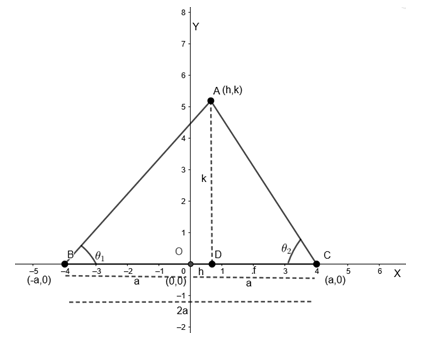Question
Question: If a given base triangle is described such that the sum of the tangents of the base angles is consta...
If a given base triangle is described such that the sum of the tangents of the base angles is constant, prove that the locus of the vertices is a parabola.
Solution
Hint: We need to take the given condition in co-ordinate plane and use tanθ=baseperpendicular in different triangles
Complete step-by-step answer:
Given that the sum of the tangents of base angles of the triangle is constant. We have to prove that the locus of the vertices is a parabola.

Let the given base of the triangle is BC of length 2a. Also let the coordinates of C be (a, 0) and B be (-a, 0) such that OB = OC = a.
We have to prove that the locus of A is parabola, so let the coordinates of A be (h, k).
Hence, we get OD = h and AD = k.
Also, given that the sum of tangents of angles B and C are constant.
Hence, we get tanθ1+tanθ2=C....(i)[C = constant]
We know that tanθ=baseperpendicular
Therefore, tanθ1=BDAD=a+hk
And tanθ2=DCAD=a−hk
Now, we will put these values in equation (i).
We get tanθ1+tanθ2=C
⇒a+hk+a−hk=C
⇒(a+h)(a−h)k(a−h)+k(a+h)=C
Cross Multiplying above equation, we know that,
(x+y)(x−y)=x2−y2
We get, 2ka=C(a2−h2)
By rearranging the equation, we get,
Ch2=Ca2−2ka
⇒h2=C−2a[k−2Ca]
Replacing h by x and k by y for the locus
⇒x2=C−2a[y−2Ca]
which is comparable to parabola.
(x−x1)2=−4a(y−y1)
Hence, we proved that the locus of vertices is a parabola.
Note: Instead of taking arbitrary points, we must take the points in co-ordinate plane like we did in this question to make the question easily solvable. We must rearrange the equation until we get the desired form.
